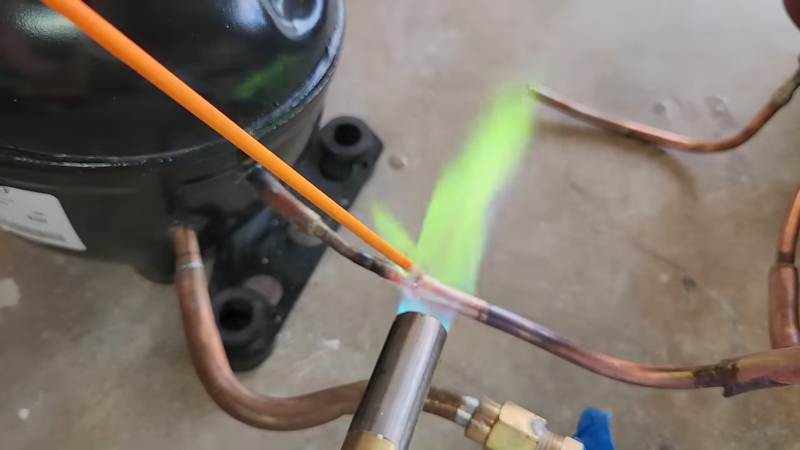Every time we check in with [Hyperspace Pirate] he’s trying to make things cold. Really cold. His recent two-part video shows a propane vapor compression system that can go down to -37° C as well as a two-stage system using homemade ethylene that can get to -83° C. He’s trying to get to -100°, so he’s close, and we have no doubt he’ll get there.
The video explains that using two different refrigerants makes the design more practical. At the low temperatures involved, you have to deal with compressor oil freezing. There is a lot of theory required to design an efficient cooler and a lot of know-how required to make gas-tight connections with all the different materials involved.
Using propane in both stages did provide a little additional cooling. But using ethylene in the second stage didn’t work as expected. There were two issues to work through. Part of it was the average temperature of the system, and also, the homemade ethylene needed purification. The ethylene purification setup was almost as complex as the main system and also reminded us, for some reason, of the movie Darkstar. It didn’t work as well as he wanted, which means we have to wait for part two to see it all actually working.
We’ve seen this same guy make dry ice. He’s also tried to make liquid nitrogen, too.
















This whole series is amazing, really worth watching thru how this evolved from attempts at a pulse tube cryocooler
I believe the goal was to get low enough with this stage that a stage using methane can come after, and then after that, liquid nitrogen production. He might choose to switch to JT cooling for the last bit.
Some papers I’ve read have made me think that a vortex tube (used with the right parameters) could be a good alternative to the JT throttling for low budget DIY. It’d take more effort to set up, but normally you don’t turboexpand the gas because it’s too hard to buy the right turbine, not because it wouldn’t produce more cooling than throttling. A vortex tube’s cold side is a suboptimal turboexpansion of the gas, and the hot side carries away half your flow in order to carry away the heat. It’s probably still cold enough to reroute into regenerative cooling though. Or into giving the main compressor of a hampson linde setup a higher input pressure for a lower pressure ratio, but then you have to balance a lot of flows.
Thats a very cool.
Here is something extra dangerous.
My homebuilt refrigeration also uses propane,in a bucket,which I use to get press fit bearings(interference fit) on a shaft, shrinking the shaft,by dunking it in liquid propane,and a slightly warm bearing drops on.
I remember some weird press fit job with grandpa like 35 years ago. Shaft in the freezer and bearing in the toaster oven or something. Depression era war vets could jury rig about anything.
That’s still commonly done at home with small engine repairs
Though do remember to thoroughly clean the parts before stuffing them in the deep freezer and oven.
Also note, depending on your country, the fine for releasing certain types of refrigeration gas into the atmosphere is quite substantial.
Having a method of making dry ice, liquid nitrogen or even liquid oxygen does sound somewhat appealing.
No doubt this method is, at least after being setup, more cost efficient than discharging a fire extinguisher into a pillow case.
Although I do wonder about using multiple stages of vortex and venturi tubes.
Vortex tubes seem to be mostly of the same design, a cone sending the cold gas back through the centre of the vortex of mixed gas, somehow that seems like it should be less efficient or at least less thermally isolated, than having a coaxial output.
From what I’ve read, it’s relatively ideal to use regenerative cooling with a single vortex tube set to maximize the cooling heat flow rather than the temperature drop. And regardless if you use one or multiple, you want to cause the pressure ratio across the tube to be the same as is implied by its normal ratings, even if you are exhausting into something above or below atmospheric, such as if you planned to use another tube in series.
Personally I’d go for a Hampson–Linde cycle and I’m kinda hoping that’s where this project ends up going.
The Hampson–Linde cycle doesn’t need a closed cycle cryocooler with exotic mediums as the final stage uses the product as the cooling medium.
Without pre-cooling as much as possible with something else, you do need a very large pressure ratio and a very large regenerative heat exchanger to do hampson-linde. If he gets into the right range, JT cooling becomes much easier. If he wants, another stage can be methane, and then since you’re below the critical point of nitrogen I guess it should be comparatively easy to liquify. I can’t say I ever did any of that, of course.
WOW! this is *THE* best refrigeration concepts video I have every seen (and I have watched a lot of them) THANK YOU for sharing!!
I love this series and just overall his channel is truly amazing